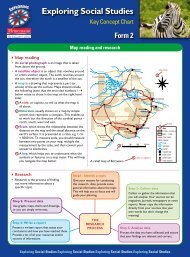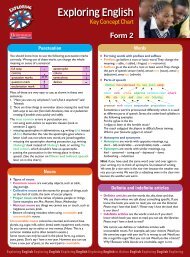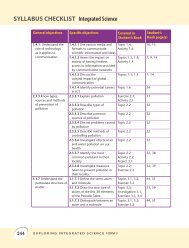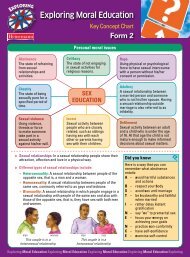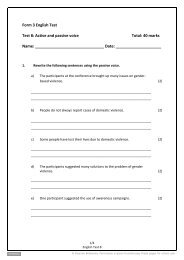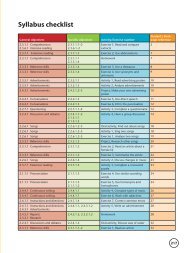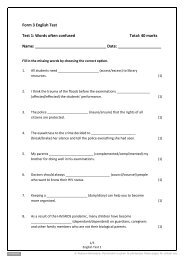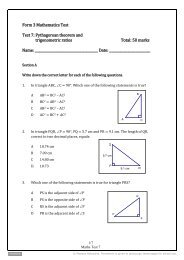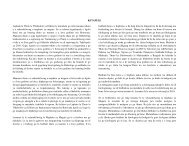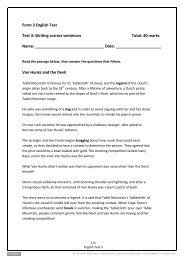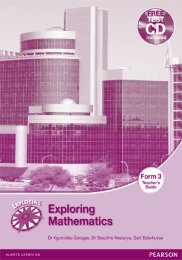Key Concept Chart - Pearson
Key Concept Chart - Pearson
Key Concept Chart - Pearson
You also want an ePaper? Increase the reach of your titles
YUMPU automatically turns print PDFs into web optimized ePapers that Google loves.
This new series consists of student’s books, teacher’s guides,<br />
key concept charts and test CDs, all aligned to the Revised<br />
Junior Secondary School curriculum for Botswana.<br />
IA INT SCIENCE 3SB CV.indd 1<br />
This course is supported by the online<br />
Your complete classroom solution!<br />
www.longmanafrica.co.za<br />
Longman books are printed on quality paper,<br />
and have sturdy, long-lasting covers.<br />
ISBN 978-99912-595-8-1<br />
9 789991 259581<br />
NEW<br />
CURRICULUM<br />
with Student’s Book!<br />
with Teacher’s<br />
Guide!<br />
Janice Barrett | Alpa Somaiya<br />
Reviewed by: Masego Basimanebotlhe<br />
2011/07/14 03:48:44 PM<br />
TOPIC 9 Body systems<br />
In Form 2, you learnt some important things about the<br />
human body. For example, you studied how your body is used<br />
for communication and<br />
The<br />
how<br />
human<br />
the sense<br />
body<br />
organs help you to<br />
communicate. You also learnt that the nervous system is made up<br />
of • many The nerves functions that make of the different skeleton muscles are react. to protect Some of these<br />
muscles, together with bones and joints, enable you to move your<br />
internal organs, support the muscles and body<br />
body. For example, you use muscles, bones and joints to walk, hold<br />
a pencil,<br />
organs<br />
kick<br />
and<br />
a soccer<br />
allow<br />
ball,<br />
body<br />
and so<br />
movement.<br />
on.<br />
• A joint is a part of the body that can bend<br />
In this because unit, we two will learn bones about meet the there. physiology of bones, muscles<br />
and • joints. For movement to happen, the action of the<br />
The muscles, main functions bones of and the joints human must skeleton be coordinated.<br />
The adult<br />
Muscles<br />
human<br />
are<br />
skeleton<br />
attached<br />
is made<br />
to bones<br />
up of 206<br />
by<br />
different<br />
tendons.<br />
bones.<br />
Limbs<br />
These<br />
bones function begin to develop as levers. before Bones birth. are As pulled newborn by babies, pairs our of bones<br />
are soft, muscles and our to bodies move are the floppy. levers. As we get older, our bones get<br />
hard • Posture and strong is and the we position can or of stand the body up straight. parts relative<br />
to one another.<br />
Look at Figure 9.1 to see all the different bones in the adult<br />
skeleton.<br />
• Good<br />
Notice<br />
posture<br />
that most<br />
involves<br />
of the<br />
aligning<br />
bones have<br />
each<br />
scientific<br />
part of<br />
names, for<br />
example, the body humerus with and the femur. neighbouring You do not need parts, to remember thereby the<br />
names keeping of the bones! them well-balanced and supported.<br />
skull<br />
cervical vertebrae<br />
clavicle<br />
scapula<br />
sternum<br />
humerus<br />
ribs<br />
vertebral column<br />
pelvis<br />
radius<br />
ulna<br />
carpals<br />
metatarsals<br />
phalanges<br />
femur<br />
patella<br />
tibia<br />
fibula<br />
The human skeleton<br />
HIV/AIDS<br />
AIDS care-givers must:<br />
• provide emotional support and practical help to<br />
AIDS patients,<br />
• respect the confidentiality of AIDS patients,<br />
• know how to prevent infections, control pain and<br />
cope with very ill patients, and<br />
• encourage patients to do gentle exercise, eat<br />
healthily and take sufficient rest.<br />
Force, motion and energy<br />
• Forces can cause stationary objects to move and<br />
moving objects to change direction or slow down.<br />
• Newton’s First Law of Motion states that an object<br />
remains at rest, or if it is moving it will continue to<br />
move with constant speed in the same direction,<br />
until a force acts on it to move it differently.<br />
• Newton’s Second Law of Motion says that when<br />
a force is applied to a moving object it causes the<br />
momentum of the object to change. The rate of<br />
change of this momentum is equal to the size of<br />
the force. The change takes place in the direction<br />
of the force.<br />
• A useful way of expressing Newton’s Second<br />
Law is the formula F = ma, where F is the force<br />
applied, m is the mass of the object and a is the<br />
acceleration of the object caused by the force.<br />
• Newton’s Third Law of Motion says that action<br />
and reaction are equal and opposite. This means<br />
that if you push against a wall, the wall is also<br />
pushing against you with the same force.<br />
New word<br />
physiology the study of<br />
how living bodies work<br />
<strong>Key</strong> concept<br />
The human skeleton is<br />
made up of 206 different<br />
bones. The main functions<br />
of the human skeleton are:<br />
to give sturdiness and<br />
provide a frame, to provide<br />
attachments for muscles<br />
and ligaments, to enable<br />
the body to move, and to<br />
provide protection for vital<br />
organs.<br />
Emerging issue<br />
Children must have good<br />
nutrition, because bones<br />
need calcium, and muscles<br />
need carbohydrates and<br />
protein to become strong<br />
and healthy.<br />
The solar system<br />
Space exploration:<br />
• provides us with more information about space<br />
beyond our Earth,<br />
• tells us what the universe was like in the distant past,<br />
• is expensive and dangerous,<br />
• has contributed to advances in types of plastic,<br />
television, computers and human health, and<br />
• relies on the skills of astronauts, pilots, computer<br />
technicians, mechanics, medical doctors, scientists,<br />
engineers, chemists and geologists.<br />
Satellites give us information about Earth. Some<br />
research satellites contain devices that can study<br />
the universe 199 from above the atmosphere, obtaining<br />
information that we cannot get on Earth.<br />
Space probes send information back about other<br />
parts of the solar system. There are many different<br />
kinds of telescopes that detect radio waves, X-rays,<br />
heat and light from objects in the universe.<br />
The solar system<br />
Figure 9.1 A front and back<br />
view of the human skeleton<br />
SO 7.4.1.1, 7.4.1.2<br />
Sun<br />
Mercury<br />
Mars<br />
Earth<br />
Saturn<br />
Uranus<br />
LONGMAN<br />
for success in Form 3!<br />
• Comprehensive content coverage<br />
• Easy, student-friendly explanations<br />
• Local examples<br />
• Exam-style assessments<br />
LONGMAN<br />
your complete classroom solution!<br />
Contact details<br />
<strong>Pearson</strong> Botswana: Tel: +267 3922969 Fax: +267 3922682<br />
Plot 14386, New Lobatse Road, G-West Industrial Site,<br />
LONGMAN<br />
Gaborone, Botswana. Website: www.longmanafrica.co.za<br />
Integrated Science Form 3<br />
FREE<br />
KEY CONCEPT CHART<br />
FREE<br />
TEST CD<br />
Form 3 • Student’s Book<br />
Venus<br />
Jupiter<br />
Neptune<br />
ISBN 978- 99912-580-5- 8<br />
9 789991 258058





